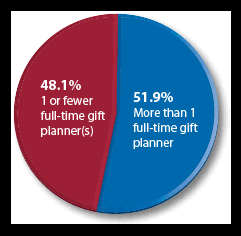The American Council on Gift Annuities (ACGA) recently released the results of a survey of gift planning among charitable organizations in the United States.
The ACGA conducted surveys in 1994, 1999, and 2004, focusing on the latest trends surrounding charitable gift annuities. The 2008 study represented an attempt to broaden the scope of previous ACGA surveys.
This nationwide survey of 864 organizations covered a broad variety of gift planning practices and activities. Those surveyed were asked about counting and crediting gifts, gift acceptance policies, gift administration, donor recognition, specific types of planned gifts, and other topics. Ten professional service providers and administrators were also surveyed as a part of this national study.
Importance of gift planning
The vast majority of respondents were optimistic about the future of charitable gift planning. Almost three-quarters characterized gift planning as “increasing in importance” at their organizations, while only 3% felt that gift planning was “decreasing in importance.” Nine out of ten professional planned gift service providers and administrators indicated that their clients were placing greater emphasis on various types of planned gifts, including charitable trusts and gift annuities.
Respondents to the survey reported a wide range of revenue. Of the charitable organizations that knew their annual revenues, some 20% had revenue of $5 million or less; 22% were in the $5 million to $20 million range; 27% reported $20 million to $100 million in revenue; and 24% were over $100 million.

There was a broad range in staffing as well. Of the respondents, 48.1% have one full-time employee or less devoted to gift planning. Another 33.4% have 2-4 full-time gift planning staff, while 11.4% reported 5-10 gift planning staff, and 7% had more than 10 devoted to gift planning.
Most successful marketing
From a marketing perspective, the survey found that referrals and targeted mailings were the most successful methods of generating planned gifts. When described as “very successful” or “somewhat successful,” targeted mailings were ranked as the most effective marketing activity by 67% of respondents. This was followed closely by articles in organizational publications and referrals from professional advisors and other development offices as successful ways to generate prospects.
Other marketing activities mentioned include check-off boxes, seminars, newsletters, articles, Web sites, and advertisements. When asked which marketing techniques were “somewhat unsuccessful” or “not successful at all,” Web sites topped the list at 39% while just 16% placed their planned giving newsletter in those categories.
Planned giving recognition societies were maintained by 81.5% of respondents. Almost 22% reported more than 500 recognition society members; 18.6% reported 201-500 members; 18.5% had 100-200 members; and the remaining 41% had 100 or fewer members.
Popular giving techniques
Charitable bequests and estate distributions were cited as the most productive source of planned gift income and new expectancies.
Just over half of those responding will serve as trustee of charitable remainder trusts, and about half of that group outsource both the investment and administration of their trusts. Another 24.9% outsource the trust investments, and only 17.4% attempt to perform both tasks in-house.
Almost 90% of survey respondents reported that their charity offers charitable gift annuities. Twenty-nine percent had more than 100 immediate payment gift annuities, 30% had 26-100 contracts, and 41% had fewer than 26 annuities.
While the 2008 survey did not address ages of gift annuitants, an ACGA survey in 2004 indicated that the average donor age was 78.1 and the average and median gift annuity amounts were nearly $60,000 and $30,000 respectively.
Over 76% of respondents stated that they always follow the ACGA suggested rates. Only about 2% regularly offer rates higher or lower than the ACGA recommendations. The remaining 22% said they would offer higher or lower rates in some instances. Some in the latter group only offered lower rates while others occasionally offered higher rates.
Some 83% said they had seen increases or no change in number of gift annuities completed over the past five years with only 17% reporting a decline in the number of gift annuities.
Immediate payment gift annuities continue to be more popular than deferred payment gift annuities. Respondents reported much higher numbers of immediate payment annuities with 58% reporting fewer than five deferred gift annuities versus 13% reporting that number of immediate annuities.
The balance of the survey examined a variety of other topics of interest to gift planners including campaign counting and crediting issues and other gift techniques, including retained life estates, bargain sales, charitable lead trusts, pooled income funds, and gifts of life insurance. The full survey results may be accessed at the ACGA Web site, www.acga-web.org.

